- Joined
- March 29, 2015
- Messages
- 566
- Reaction score
- 292
- City, State
- Orangevale, California
- Year, Model & Trim Level
- 2015 Ford Explorer Sport
Yes, it is an additive. And the problem with using Dex-Cool in a system designed for the green coolant had nothing to do with air. Green coolant and any form of OAT (dex-cool) coolant are VERY incompatible. If a proper flush wasn't performed than the two form a sludge. And not sure what you mean by "submerged" as the coolant system (in ANY variant) is a closed loop system...with or without degas bottles.Cor-Guard sounds like some technology/additive, not a specific type of anti-freeze. There are millions of Ford and GM vehicles using Dex-Cool/Orange without heater core issues. My old Fords that used the green 2-year stuff would develop heater core issues. I believe the problem with Dex-Cool was the use of the old school radiators that allows air to sit in the system. The newer plastic degas bottles pretty much keep the entire system submerged in Dex-Cool so it prevents that nasty corrosion. I am not sure about the Transit design but I wouldn't put it past the heater cores not being below the degas bottle or something similar. My Fusion Sport would make gurgling noises if I filled to the mark on the bottle, so we found that overfilling the bottle solves that problem.
And understand that the new yellow stuff is still "dex-cool" now with the phosphate additive. Which is what I mentioned earlier that the Prestone WITH Cor-Guard (apologies for forgetting the "WITH" earlier) is. Please go back and read some of those links I provided...it will help you understand it better.











